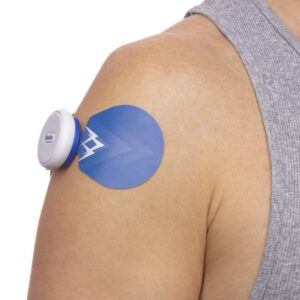Neurotherapists: Stop shouldering the blame. It’s time to rethink electrode placement for treating subluxation.
Shoulder subluxation, defined as a partial or incomplete dislocation that usually stems from changes in the mechanical integrity of the joint (muscles, tendons, ligaments) is a common issue with hemiplegic stroke survivors. There are several protocols for treating subluxation, such as electrical stimulation, but it’s often done improperly due to misconceptions about what’s considered “standard practice.”
Studies suggest that the supraspinatus and posterior deltoid muscles are the primary muscles to target when using electrical stimulation. Contrary to popular belief, this may not be the case. This blog aims to revisit what we already know about subluxation and proximal migration and challenge traditional beliefs many of us have embraced throughout our careers.
Let’s dive into when to use electrical stimulation and what the optimal muscles are for targeting.
When to Use Electrical Stimulation for Subluxation
Neuromuscular Electrical Stimulation (NMES) is a procedure in which small electrical impulses are used to stimulate affected muscles that are weak. It helps to increase muscle strength, blood circulation, and range of motion and to lessen muscle spasms. This is done by applying electrical current to the targeted muscles, which will trigger the desired movement. There are two e-stim devices on the market that can be used to strengthen weakened muscles such as the SaeboStim Pro and the SaeboStim One.
Electrical stimulation is best applied during Brunnstrom stages 1-3 when the individual has little to no volitional movement.
The Muscles You Should Be Targeting
As a neurotherapist, you might have referenced research articles by Basmajian et al., stating that the supraspinatus and posterior deltoid were the two muscles to target for surface stimulation, given the vertical vectors of each muscle.
Despite there being limited evidence, many of us have never questioned if these placement sites were actually the best for lifting the humerus up into the joint (proximal migration).
More recent research suggests that supraspinatus is not one of the top two muscles to stimulate for subluxation (in fact it’s not even in the top five). Over the past 10 to 15 years, studies have emerged debunking the ideas around supraspinatus and e-stim. The studies concluded that supraspinatus is not one of the top muscles to stimulate for two main reasons:
1. The prevalence of supraspinatus asymptomatic tears is as high as 50 percent in the stroke population (similar to age adjusted group). Ouch, this means stimulating a torn tendon could make matters worse!
2. Cadaveric and percutaneous stimulation studies have emerged showing that the supraspinatus is not a powerful proximal migrator, despite earlier theories.
Instead, occupational therapists should be targeting the middle deltoid and the posterior deltoid first (Chae et al.), since the most common type of subluxation associated with hemiplegia is inferior subluxation.
Inferior subluxations occur as a result of muscle weakness that leads to a downward rotation of the scapula in relation to the thorax (learn more about the other types of instability here). When this happens, the labrum and inferior portion of the glenoid fossa can no longer provide sufficient support to secure the humeral head into the glenoid. In addition to the faulty mechanics at the scapula, the proximal migrators of the shoulder (deltoids) are no longer able to support the weight of the arm. Gravitational forces applied to the weakened arm stretches the inert and non-inert structures to the point that the humeral head migrates distally below the glenoid fossa.
The best way to lift the humerus back up is by stimulating the muscles that are optimal for superior translation. These are the top five muscles to target when applying an e-stim device to a patient (Halder et al.):
- Middle deltoid
- Posterior deltoid
- Long head of biceps
- Coracobrachialis
- Long head of triceps
Supraspinatus is number six!
Electrical Stimulation Devices
The following e-stim devices can be applied to help stimulate movement in hemiplegic stroke survivors dealing with shoulder subluxation. It’s important to note that electrical stimulation is not safe for all patients, including those who are pregnant, or using a cardiac pacemaker or defibrillator.
The SaeboStim One, a wireless electrical stimulation device, is designed to prevent or reduce muscle weakness by strengthening the affected muscles. This device has one pre-set Neuromuscular Electrical Stimulation (NMES) program for ease of use and is ideal to treat shoulder subluxation.

The SaeboStim Pro is an advanced neuromuscular electrical stimulation device. This device is designed to improve motor impairment, reduce pain, re-educate and strengthen weakened muscles and offset the effects of disuse after a neurological or orthopedic injury. It can be used to re-educate muscles to perform everyday tasks in both the upper and lower limb. The SaeboStim Pro device includes a comprehensive range of programs to choose from: NMES for muscle strengthening, Transcutaneous Electrical Nerve Stimulation (TENS) for pain relief, and sensory stimulation with our Sensory Electrical Stimulation (SES) Accessory Kit. In addition, the unique trigger button allows you to use it as a Functional Electrical Stimulation (FES) device to practice everyday tasks.

Conclusion
As clinicians, we are great at adapting and modifying to maximize outcomes, yet therapists continue to recommend supraspinatus as one of the key muscles for electrode placement.
Now is a good time to “close the gap” on traditional concepts and update our electrode placement guidelines for subluxation.
All content provided on this blog is for informational purposes only and is not intended to be a substitute for professional medical advice, diagnosis, or treatment. Always seek the advice of your physician or other qualified health providers with any questions you may have regarding a medical condition. If you think you may have a medical emergency, call your doctor or 911 immediately. Reliance on any information provided by the Saebo website is solely at your own risk.

